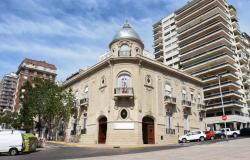The restlessness that she had from a very young age made her discover her passion for photography in Ireland, a country where she went when she was 17, equipped with the camera that her grandmother gave her. Patricia Laiseka from Durango began to portray landscapes during the … weekends and in your free time. Now she has decided to combine nature and bodies in an exhibition titled ‘Negua bistan’ (Winter in view), made up of thirteen polaroid photographs that can be enjoyed at the Oreka bar in Iurreta.
«I have always been very curious and for a decade, the photo machine has accompanied me on that path that is life. Shortly after I lived in Barcelona, where my head exploded with the artistic world, with all the culture there was, and I began to demonstrate that sensitivity to light, shadows and the environment that surrounded the city. In a sabbatical year I dedicated myself, solely and exclusively, to visiting museums, attending talks and photography research centers, laboratories and workshops. That’s when I said to myself: ‘This is my passion, what I love,'” the 27-year-old explains.
The snapshots are taken in the original SX-70 format, the same one that Andy Warhol used to portray his artists. They contain a secret: they came out a little blue due to the internal chemicals and he decided to give them that title and also add them for their connotation: cold, physical energy, sobriety. Her photographs are accompanied by poetry in Basque in the form of a reflection on what her work has meant to her.
«It is an art that awakens»
«There are black and white images and also color polaroids. I have discovered an inner world that I was unaware of and I think it is very important to project it to other people and that, through them, they discover parts of themselves that they do not know, whether they are emotions, feelings… Photography is an art that has the ability to awaken something inside you,” he says.
After studying a Business degree in Barcelona, Laiseka decided to complete a specialized higher degree at the Euskadi public art and design school (IDarte) in Vitoria-Gasteiz and is currently a historical archive technician at the Gerediaga cultural association.
«The landscapes – some of them located on the road to Urkiola – are those that we love to observe, especially at the change of seasons; and there are also photos of naked bodies where you have to pay close attention and look at them carefully to identify the different parts,” he confesses.
The exhibition, which will remain open to the public until mid-June, seeks in the author’s words to make viewers reflect on the relationship that the body maintains with nature. «We are part of it, within what we call the universe, the cosmos. We express emotions that we go through when we change seasons, from autumn-winter to spring. At first we are like hermits, we enter a recession of energy or cold, we are cramped and that is also reflected in the trees that lose their leaves, they become naked. We take off some layers and put on others when it begins to flourish and be reborn, with a greater amount of energy and light and the desire to do many things,” she details.
In the aforementioned bar, run by a woman, Yomara, with great cultural concern, wants to create synergies of culture and different arts and artistic disciplines. The author also does not want to forget her friend and historian Jon Irazabal, who was looking for a wall in Iurreta to display works and chose this place, where she has exhibited after having shown a trip to New York or reflecting on the covid, with the aim of create different cultural dynamics in the town.
In her next project she is working on, ‘Guardianas’, she is about those women who are forgotten in the rural areas of Duranguesado and who continue to live in hamlets to this day. «They have been guardians of their family, their land, their environment. They act as protectors of all their ties and in history they have not had the most important role. As a society, we are emphasizing care and I want to give a voice to these women and to memory. “They represent a way of life,” concludes this young neighbor.





